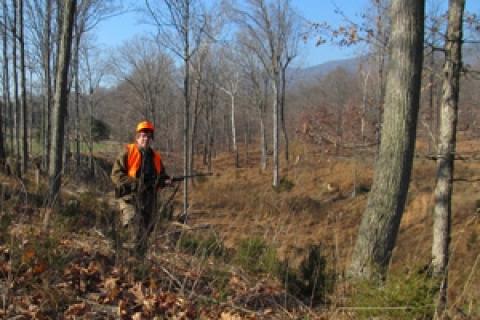
 Jump shooting bucks consists of walking at a moderate pace trying to roust out a buck and drop it as it gets up or loads its legs to take its first jump. It differs from still hunting in that you don't try to sneak up and spot deer ahead, but simply try to push them out. It's demanding hunting, and you should practice snap-shooting before you try it.
Jump shooting bucks consists of walking at a moderate pace trying to roust out a buck and drop it as it gets up or loads its legs to take its first jump. It differs from still hunting in that you don't try to sneak up and spot deer ahead, but simply try to push them out. It's demanding hunting, and you should practice snap-shooting before you try it.
Jump shooting can work in a lot of situations but one of the best places to try it is a stream bottom or wet ditch with thick cover. Deer find shelter there, prime bedding sites and food such as such as saplings, honeysuckle, sumac, raspberry, blackberry, olive, plum and willow.
In early season and during the pre-rut, it's usually best to take a stand in these locations and wait for the deer to come to you. But as the season progresses, and peak rut and post rut arrive, it sometimes pays to climb down from that stand and start walking. The tactic is especially good when it's raining or lightly snowing.
During the cold, wet weather the deer will likely be bedded down and you won't see much if you just sit on stand. You can also move quietly in the damp woods and the deer won't be as likely to hear you.
In especially good areas it can pay to throttle down a bit and work more slowly, trying to spot the quarry ahead as you work with the wind crossing or in your face. Use your binoculars to peer into thick cover and search for a part of a deer or the glint of an antler in sunlight.
In less promising spots, move at a more casual walking pace. The aim is to kick a buck up out of a brush pile or tall grass and get a jump shot. A crossing wind is best because it usually allows the closest approach, with deer facing downwind.
Concentrate on brush piles and blowdowns, zigzagging through the cover along the stream. If a buck jumps and you don't get a shot, swing downwind 100-200 yards. You might find the buck circling back to see what jumped it.
A light, fast-handling gun with a low power or red dot scope is best for this hunting, or even iron sights. Shots can be quick and instinctive, and they're usually close.
It's a lot like grouse hunting. Carry the gun at port arms, safety on and be ready to make a quick decision on age and trophy quality.
Jump Shooting Gear
- quick handling gun
- low power scope or iron sights
- quiet clothing (wool or fleece)
- low power binoculars
- wind monitor
- cover scent
- blaze orange vest and hat
- 2751 views

